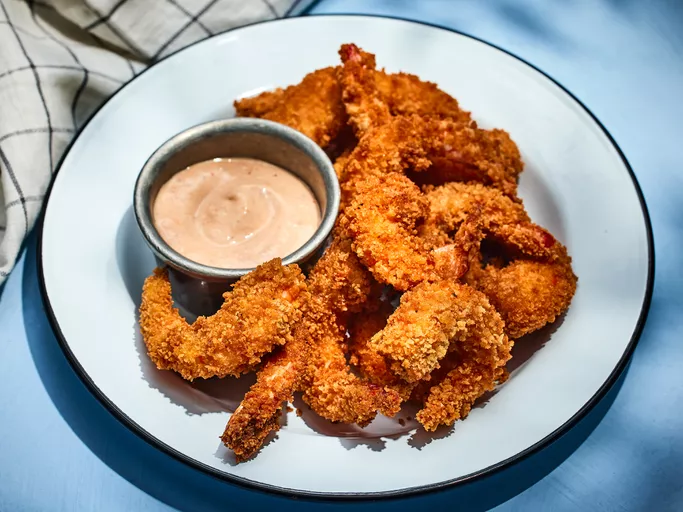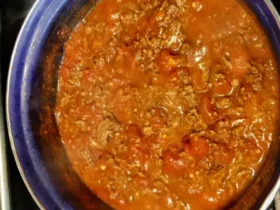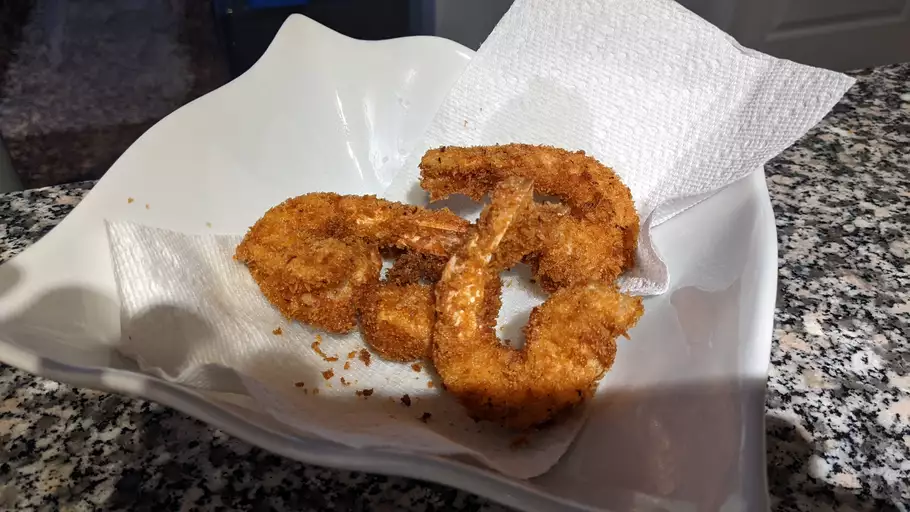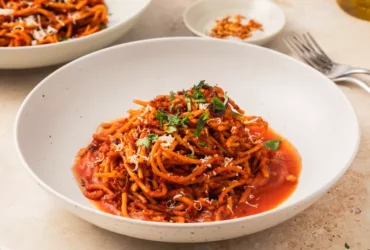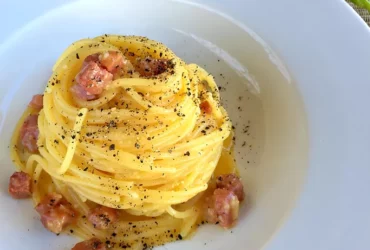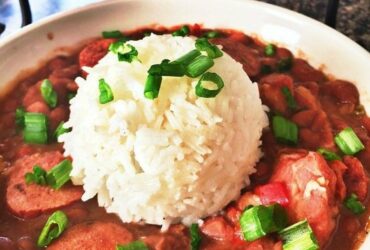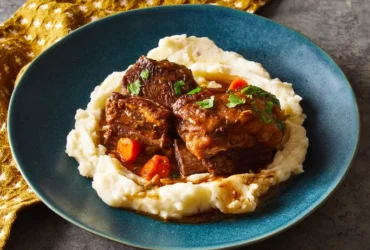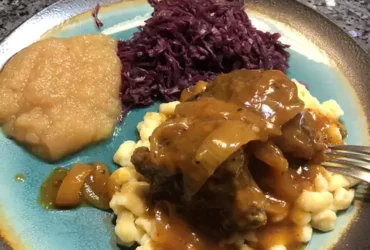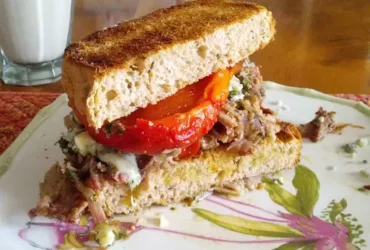Ingredients
Shrimp
Shrimp is a fundamental ingredient in the Japanese-Style Deep-Fried Shrimp Recipe, and its quality can significantly impact the final dish’s flavor and texture.
Here are some key characteristics to look for when selecting shrimp:
Freshness
Choose shrimp with a pleasant oceanic aroma, firm texture, and vibrant color. Shrimp that smell sour or ammonia-like are likely spoiled.
Species
Pandalus borealis (Northern shrimp) or Parapenaeus longirostris (Southern shrimp) are popular choices for their sweet flavor and firm texture. Other species, like Litopenaeus vannamei (Gulf whiteleg shrimp), may be available depending on the region.
Size
For Japanese-Style Deep-Fried Shrimp, it’s best to use medium-sized shrimp (about 10-15 per pound). Larger or smaller shrimp can alter the cooking time and texture.
When preparing the shrimp for frying, it’s essential to remove any impurities and improve their flavor:
- Deveining: Remove the dark vein along the shrimp’s back by gently cutting down with a small knife. This helps prevent the development of off-flavors.
- Peeled and de-veined: Peel off the shell, leaving only the tail section intact for handling. De-veine the shrimp as described above to enhance texture and flavor.
In addition to the quality and preparation of the shrimp, the correct seasonings will also significantly impact the final dish:
- Salt: A light coating of salt enhances the shrimp’s natural sweetness without overpowering its delicate flavor.
- Panko breadcrumbs: For a crispy exterior, lightly coat the shrimp with panko breadcrumbs after seasoning. This helps maintain the shrimp’s texture and prevents it from becoming too greasy during frying.
With the right ingredients in place, the Japanese-Style Deep-Fried Shrimp Recipe is sure to delight even the most discerning palates!
1 pound large shrimp, peeled and deveined
To prepare delicious Japanese-Style Deep-Fried Shrimp, you will need a specific set of ingredients. Here’s a detailed breakdown of what you’ll require:
Meat and Seafood
- 1 pound large shrimp, peeled and deveined: This is the star ingredient of our recipe. Look for fresh, succulent shrimp that are perfect for deep-frying.
In addition to the shrimp, you’ll also need a few other ingredients to create this Japanese-style dish:
Seasonings and Spices
- Cake flour (or all-purpose flour): This will help coat the shrimp evenly before deep-frying.
- Katakuri starch (or cornstarch): Another essential ingredient for coating the shrimp, providing a crispy exterior.
- Shio koji (or Japanese soy sauce and sake mixture): A key component in creating the signature flavors of Japanese cuisine. This will add depth and umami to your dish.
Oil and Frying Agent
- Peanut oil or vegetable oil: For deep-frying, you’ll need a neutral-tasting oil with a high smoke point. Peanut oil is an excellent choice for this recipe.
Lastly, garnishes can add visual appeal to your dish:
Garnishes
- Sliced green onions (or thinly sliced shiso leaves): Add a pop of color and freshness with these fragrant herbs.
Now that you have all the necessary ingredients, let’s move on to preparing your Japanese-Style Deep-Fried Shrimp!
According to the USDA, shrimp should be purchased from a reputable source to ensure food safety.
To make the delicious Japanese-Style Deep-Fried Shrimp, you’ll need to focus on selecting high-quality ingredients that will bring out the best flavors and textures in your dish. Here are some key components to consider:
Main Ingredients:
Shrimp (10-12 count per pound)
Freshness is crucial when it comes to shrimp, as they can spoil quickly. According to the USDA, shrimp should be purchased from a reputable source to ensure food safety.
Sushi rice
Short-grain Japanese rice is the preferred choice for this recipe, as its stickiness helps hold the ingredients together.
Additional Ingredients:
- Panko breadcrumbs: Light and airy, panko breadcrumbs provide a satisfying crunch to the dish.
- Eggs: Beaten eggs help bind the shrimp and rice mixture together, ensuring that it holds its shape during frying.
- Flour: All-purpose flour helps create a light coating on the shrimp, while also aiding in the frying process.
Seasonings and Marinades:
- Soy sauce: A combination of soy sauce and sake provides a deep umami flavor that complements the shrimp nicely.
- Rice vinegar: Used in marinading and seasoning, rice vinegar adds a touch of acidity to balance out the dish.
Garnishes and Toppings:
- Sesame seeds: A sprinkle of sesame seeds provides a nutty flavor and crunchy texture, adding depth to the dish.
- Pickled ginger: Thinly sliced pickled ginger adds a tangy and refreshing contrast to the rich flavors of the shrimp.
Batter Mix
The key to making a delicious and authentic Japanese-Style Deep-Fried Shrimp dish lies in the quality and combination of ingredients used in the batter mix.
Here’s a detailed breakdown of the essential ingredients needed for an exceptional batter mix:
All-Purpose Flour ( hōtto)
This is the base ingredient in the batter mix. Japanese-Style Deep-Fried Shrimp typically uses a combination of all-purpose flour and cornstarch or potato starch for a light and crispy coating.
Cornstarch ( kōn tosu)
Adding cornstarch to the batter mix helps to create an extra crunchy exterior while maintaining the tender interior of the shrimp. Use a high-quality cornstarch that’s finely ground for best results.
Potato Starch ( tatamu satō)
Potato starch is another common additive in Japanese-Style Deep-Fried Shrimp batter mix. It adds an airy and delicate texture to the coating without making it too dense or heavy.
Japanese Curry Powder ( karē pāfu)
This secret ingredient is commonly used in Japanese-Style Deep-Fried Shrimp to give the dish a distinct flavor profile that’s slightly sweet and savory. Use a high-quality Japanese curry powder for best results.
Mirin ( mirin)
A small amount of Mirin, a sweet Japanese cooking wine, is added to the batter mix to enhance the overall flavor profile. This ingredient helps balance out the saltiness and adds a hint of sweetness to the dish.
Sugar ( sukaa)
White granulated sugar is used sparingly in some recipes to balance out the savory flavors in the Japanese-Style Deep-Fried Shrimp batter mix. Use only a small amount to avoid making the coating overly sweet.
Green Onion or Scallion (ninniku)
Chopped green onion or scallion is sometimes added to the batter mix for an extra layer of flavor and texture.
Salt (shio)
A pinch of salt is used to enhance the overall flavor profile in some recipes. Japanese-Style Deep-Fried Shrimp typically uses a light hand when it comes to salt, as the other ingredients are carefully balanced to avoid overpowering the dish.
Egg (tamago)
Some recipes use an egg yolk or beaten egg to help bind the batter mix together. This ingredient adds moisture and helps keep the coating light and crispy.
1 cup all purpose flour
All-purpose flour is an essential ingredient in many baked goods and cooking applications, including the Japanese-Style Deep-Fried Shrimp recipe. The type of flour used can significantly impact the texture and flavor of the final product.
In this specific recipe, 1 cup of all-purpose flour serves as a coating agent for the shrimp, providing crunch and structure to the dish. All-purpose flour is a versatile wheat flour that contains both hard and soft flours in a single blend. This combination allows it to be suitable for a wide range of recipes, from baked goods to fried foods.
The role of all-purpose flour in Japanese cuisine often involves creating light and airy textures. In the context of deep-frying, this characteristic helps prevent the breading or coating from becoming too heavy or dense, which can result in an unpleasant texture. Instead, the all-purpose flour mixture adheres to the shrimp evenly and provides a crispy exterior while maintaining the delicate interior.
It’s essential to note that using all-purpose flour as opposed to other types of flour is crucial for achieving the right balance of texture and flavor in this recipe. Bread flour, for example, would produce a heavier and more dense breading due to its higher protein content, while cake flour might result in a too-light coating.
The choice of all-purpose flour in Japanese-Style Deep-Fried Shrimp allows cooks to create an authentic and flavorful dish that balances the savory taste of the shrimp with the crunchy texture of the coating. When combined with other ingredients like sake, mirin, and soy sauce in the recipe’s marinade mixture, all-purpose flour contributes to a well-rounded culinary experience.
1/2 teaspoon salt
The key to achieving the perfect flavor in our Japanese-Style Deep-Fried Shrimp recipe lies in the selection and preparation of its ingredients.
We’ll begin with the seasoning, where a pinch of salt plays a crucial role. A total of 1/2 teaspoon is required for this recipe, which may seem like a small amount but trust us when we say that it’s just right.
This salt, often overlooked in many recipes, serves as more than just a flavor enhancer; it helps to balance the sweetness of the shrimp and adds depth to the dish. When selecting your salt, opt for an unrefined or flaky type to maximize its potential.
1/4 teaspoon white pepper
In this recipe for Japanese-Style Deep-Fried Shrimp, the addition of 1/4 teaspoon white pepper plays a crucial role in enhancing the overall flavor and aroma of the dish.
White pepper is a type of peppercorn that has been treated to remove its outer shell, resulting in a finer texture and a more delicate flavor compared to black pepper.
The use of white pepper in Japanese cuisine is particularly common when cooking seafood dishes like this one, as it adds a subtle yet distinct flavor profile that complements the natural flavors of the ingredients without overpowering them.
Here’s where you can find white pepper in most supermarkets or Asian markets:
Spice aisle
White pepper is often found alongside other types of peppercorns and spices in the spice aisle.
International or Asian market
If you’re having trouble finding white pepper at your local supermarket, try checking an international or Asian market instead. They usually carry a wider selection of spices, including white pepper.
To use white pepper effectively in this recipe:
- Add the white pepper to the marinade: Mix the white pepper into the marinade along with other seasonings like soy sauce and sake to create a flavorful base for your shrimp.
- Use it as a finishing spice: Just before deep-frying the shrimp, sprinkle a pinch of white pepper over the top for an extra burst of flavor.
The benefits of using white pepper in this recipe include:
- Enhanced flavor: White pepper adds a subtle yet distinct flavor profile that complements the natural flavors of the ingredients without overpowering them.
- Visual appeal: The fine texture of white pepper makes it a great addition to dishes where presentation is key, like this Japanese-Style Deep-Fried Shrimp Recipe.
1/4 teaspoon paprika
The ingredients used for this Japanese-Style Deep-Fried Shrimp Recipe are a crucial component in achieving its authentic flavor and texture.
Main Ingredients
Here’s a list of main ingredients needed:
Prawns/Shrimp
Fresh, peeled, and deveined prawns or shrimp with heads removed will give the best result. It is recommended to purchase them from a reputable seafood store.
All-purpose Flour
This flour helps in creating a crispy coating on the shrimp by acting as an adhesive for other ingredients.
Vegetable Oil
A neutral-tasting oil with a high smoke point such as peanut or avocado oil is ideal for frying. This will prevent the oil from breaking down and absorbing into the food, leading to undesirable flavors and textures.
Panko Breadcrumbs
These Japanese breadcrumbs are lighter than regular breadcrumbs and provide an airy texture that helps the shrimp stay crunchy outside while remaining tender inside.
Soy Sauce
This adds umami flavor, which is a key component in many Japanese recipes. It should be used sparingly to avoid overpowering the other ingredients.
Sake (or dry white wine)
A small amount of sake or dry white wine contributes to the depth of the flavor profile and helps tenderize the shrimp.
Green Onions
Thinly sliced green onions serve as a garnish, adding freshness and color to the dish. They can be used in any Japanese recipe that calls for garnishing with green onions.
Sesame Oil
A small amount of sesame oil adds a distinct nutty flavor and aroma, often used in Japanese cuisine to give dishes an extra depth of flavor.
Paprika
For the purpose of this recipe, it is recommended that you use only 1/4 teaspoon paprika.
Smoked or sweet paprika can be used depending on your preference; however, smoked paprika will give a smoky flavor whereas sweet paprika has a sweeter and milder taste.
Additional Ingredients
The following are additional ingredients that may be required depending on the personal preferences of the cook or regional variations in recipes.
Miso Paste
For those who want to add a deeper umami flavor, a small amount of miso paste can be added while marinating the shrimp. This should be used sparingly as it is quite strong and could overpower other flavors.
Grated Ginger
Grating some ginger adds another layer of complexity in flavor profiles that many Japanese recipes incorporate. However, its usage might require adjusting based on personal taste preferences.
Mayonnaise or Yuzu
A small amount of mayonnaise can be used to help the breadcrumbs adhere to the shrimp. For those looking for an authentic Japanese taste experience, yuzu may be used in place of lemon juice for its unique citrus flavor.
Tips and Variations
Here are some tips and variations you might find helpful while making this recipe or experimenting with new ingredients:
- For a lighter coating on the shrimp, reduce the amount of panko breadcrumbs or use plain flour as an alternative.
- You can also add other seasonings like salt, pepper, garlic powder, or dried herbs to suit your taste preferences.
- Experiment with different types of oil and their smoke points for frying to achieve a variety of flavors.
1/4 teaspoon cayenne pepper (optional)
The ingredients for this Japanese-Style Deep-Fried Shrimp recipe are as follows:
- 1 pound large shrimp, peeled and deveined
- 1/2 cup all-purpose flour
- 1/2 teaspoon salt
- 1/4 teaspoon black pepper
- 1 egg, lightly beaten
- 1 cup panko breadcrumbs
- Optional
- 1/4 teaspoon cayenne pepper
Cayenne pepper is an optional ingredient that adds a touch of heat to the dish. If you prefer a milder flavor, simply omit it from the recipe.
According to a study by the University of California, Davis, using spices and seasonings can enhance flavor and aroma.
When it comes to cooking Japanese-Style Deep-Fried Shrimp, using the right ingredients is crucial to bring out the authentic flavors and aromas of this popular dish.
The key to a successful Japanese-Style Deep-Fried Shrimp recipe lies in the combination of fresh ingredients, expertly selected spices and seasonings, and proper cooking techniques.
In this article, we will delve into the world of ingredients used in traditional Japanese cuisine and provide you with a comprehensive guide on how to prepare and use them for an exceptional Japanese-Style Deep-Fried Shrimp experience.
According to a study by the University of California, Davis, using spices and seasonings can enhance flavor and aroma.
This concept is particularly relevant when it comes to Japanese cuisine, where subtle yet distinct flavors are often achieved through the strategic use of herbs and spices.
Some essential ingredients you will need for Japanese-Style Deep-Fried Shrimp include:
- Jumbo shrimp: Fresh or frozen jumbo shrimp with shells on are perfect for this recipe.
- All-purpose flour: A must-have for coating the shrimp, all-purpose flour helps to create a crispy exterior and tender interior.
- Panko breadcrumbs: Light and airy Panko breadcrumbs add a satisfying crunch to the dish while keeping it light.
- Vegetable oil: For frying the shrimp, choose a high-quality vegetable oil with a smoke point suitable for deep-frying.
- Soy sauce: A staple in Japanese cuisine, soy sauce brings depth and umami flavor to the dish.
- Sake or mirin: These ingredients add a subtle sweetness and a hint of sake’s unique flavor profile to the shrimp.
- Yuzu pepper: For an added burst of citrusy freshness, try using yuzu pepper, a type of Japanese pepper made from fermented citrus peel.
- Ginger: Thinly sliced fresh ginger adds warmth and depth to the dish while providing an aromatic touch.
- Celery seeds: These tiny seeds offer a delicate, herbal flavor and aroma that pairs well with the shrimp’s sweetness.
- Sesame oil or sesame seeds: For garnish, use either toasted sesame oil or sesame seeds for added crunch and nutty flavors.
Beer Batter
The beer batter used for Japanese-style deep-fried shrimp typically consists of a combination of ingredients that provide a light and crispy texture, along with flavors that complement the sweetness of the shrimp.
One common ingredient in beer batter is all-purpose flour, which serves as the base of the batter. The type of flour used can vary depending on personal preference or regional traditions, but all-purpose flour is generally the most widely accepted choice.
Breadcrumbs are another essential component of the beer batter. Panko breadcrumbs, in particular, are often preferred for their lighter and crisper texture compared to regular breadcrumbs. This helps achieve a delicate crust that doesn’t overpower the flavor of the shrimp.
Beer is, of course, an integral ingredient in this recipe. It adds moisture, tenderness, and a subtle depth of flavor to the batter. A light-colored beer with minimal hop bitterness works best for Japanese-style deep-fried shrimp.
Salt and sugar are used to enhance the flavors within the batter without overpowering the sweetness of the shrimp. The proportions of these two ingredients can vary depending on individual taste preferences, but a balanced ratio is generally recommended.
A pinch of black pepper adds a subtle heat and aroma to the beer batter, while also contributing to its overall depth of flavor.
Some Japanese-style deep-fried shrimp recipes may include additional ingredients, such as grated ginger or sesame seeds, which add further layers of flavor and texture to the dish. These ingredients can be adjusted according to personal taste preferences and regional traditions.
The proportions of these ingredients in the beer batter for Japanese-style deep-fried shrimp typically follow a basic ratio:
- 1 cup all-purpose flour
- 1/2 cup panko breadcrumbs
- 1/2 cup beer (cold)
- 1 tablespoon sugar
- A pinch of salt and black pepper (adjust to taste)
The exact proportions can vary depending on personal preference or regional traditions. Feel free to experiment with different ratios to find the perfect balance for your Japanese-style deep-fried shrimp recipe.
1 cup beer (preferably Japanese rice lager)
The key to making authentic Japanese-style deep-fried shrimp lies not only in the cooking technique but also in the selection of ingredients, particularly when it comes to the type of beer used in the batter.
In this recipe, we’re looking for a beer that complements the delicate flavor of the shrimp without overpowering them. A Japanese rice lager is an ideal choice here, as its crisp and clean profile will help create a light, airy batter.
Japanese rice lagers are brewed using rice in addition to barley malt, which gives them a distinct flavor and aroma. This type of beer is perfect for this recipe because it will not only add depth to the batter but also help to enhance the natural sweetness of the shrimp.
Other types of beer, such as pilsners or pale ales, may work in a pinch, but they’ll alter the flavor profile and texture of the batter in undesirable ways. The subtle nuance of Japanese rice lager is what makes it the perfect choice for this recipe.
When selecting your Japanese rice lager, look for a brand that’s brewed with high-quality ingredients and has a crisp, refreshing taste. Some popular brands include Asahi, Sapporo, and Kirin.
In summary, the 1 cup of beer called for in this recipe is an essential component of creating authentic Japanese-style deep-fried shrimp. By choosing a high-quality Japanese rice lager, you’ll be able to create a light, airy batter that complements the delicate flavor of the shrimp and enhances their natural sweetness.
Preparation
Prepare the Shrimp
To begin preparing the shrimp for the Japanese-Style Deep-Fried Shrimp recipe, start by purchasing high-quality prawns or large shrimp. These should be fresh and firm to the touch. Rinse them under cold running water to remove any dirt or debris, making sure to clean out the gills and guts.
Next, pat the shrimp dry with paper towels to remove excess moisture. This step is crucial in achieving a crispy exterior when deep-frying. Place the shrimp on a wire rack set over a baking sheet or tray lined with parchment paper. Allow them to air-dry for about 10-15 minutes. This process helps in preventing the formation of excess batter when dredging.
While the shrimp are drying, prepare the flour mixture by combining 1/2 cup all-purpose flour, 1/4 cup potato starch, and 1/4 cup cornstarch in a shallow dish or plate. Add a pinch of salt to this mixture as well. In another separate container, beat 1 egg lightly with a fork until it’s just combined.
To dredge the shrimp, dip each one first into the beaten egg to coat evenly, and then gently roll it through the flour mixture to coat. Make sure the shrimp is fully coated but do not press down on them as this can lead to dense batter. Set the floured shrimp aside on a plate or tray until ready to fry.
By following these steps, you will have properly prepared your shrimp for frying and are now ready to proceed with the remaining instructions in the Japanese-Style Deep-Fried Shrimp recipe.
Rinse the shrimp under cold water, pat dry with paper towels
To prepare the shrimp for frying in a Japanese-style deep-fried shrimp recipe, it’s essential to start with fresh and clean ingredients. The first step involves rinsing the shrimp under cold water to remove any impurities or debris that may be attached to their surface.
This process helps to remove any excess moisture from the shrimp, which can lead to a greasier final product if not properly drained. By rinsing the shrimp under cold running water, you’ll be able to wash away any unwanted substances and ensure your shrimp are squeaky clean.
After rinsing the shrimp under cold water, it’s crucial to pat them dry with paper towels. This step may seem insignificant, but it plays a vital role in ensuring the shrimp cook evenly and don’t become greasy during frying.
When you pat the shrimp dry with paper towels, you’ll be able to remove excess moisture from their surface, which can lead to a crispy exterior when fried. The drier the shrimp are before frying, the crisper they will turn out in the end.
So, make sure to rinse the shrimp thoroughly and then gently pat them dry with paper towels to prepare them for the next step in your Japanese-style deep-fried shrimp recipe. By following these simple steps, you’ll be well on your way to creating delicious and crispy fried shrimp that will impress anyone who tries them.
Mix the Batter
To prepare for mixing the batter, you will need to combine all-purpose flour and cornstarch in a large bowl. The ratio recommended for this recipe is one part flour to two parts cornstarch. This mixture provides the necessary structure and helps achieve a light and crispy coating when the shrimp are deep-fried.
Next, add some salt to the dry ingredients to bring out the flavors of the dish. The amount of salt depends on personal preference; however, it’s essential to note that a pinch will suffice in most cases. Too much salt may overpower the delicate flavor of the shrimp.
Now, gradually pour cold sparkling water into the bowl while gently whisking the mixture with a fork. This step is crucial as it prevents lumps from forming and creates air pockets within the batter, which contributes to its lightness. The cold water should be poured in increments until you achieve a smooth consistency.
When adding the water, it’s also essential to note that sparkling water works better than regular water due to its unique properties, which include the presence of carbon dioxide. This gas helps maintain the batter’s lightness and provides an added texture when deep-fried.
The mixture should resemble a smooth and consistent pancake batter at this point. To ensure it is well-mixed, simply scrape down the sides and bottom of the bowl using a spatula to collect all the dry ingredients. This step guarantees that every component has been incorporated evenly into the batter.
In a large bowl, whisk together flour, salt, white pepper, paprika, and cayenne pepper (if using)
To prepare this Japanese-Style Deep-Fried Shrimp recipe, it’s essential to start with a well-prepared batter that will give your shrimp a crispy and flavorful exterior. The key to achieving this is in the preparation of the flour mixture.
Begin by whisking together 1 cup of all-purpose flour, 1/2 teaspoon of salt, 1/4 teaspoon of white pepper, 1/4 teaspoon of paprika, and 1-2 dashes of cayenne pepper (if you’re using it) in a large bowl.
The type of flour used is crucial in this recipe. All-purpose flour works best for Japanese-style deep-fried shrimp as it provides the right balance of structure and texture to the batter.
It’s essential to whisk the ingredients together thoroughly until they are evenly mixed. This ensures that the seasonings are distributed throughout the flour, giving your shrimp a uniform flavor.
When adding salt, use a light hand as too much can overpower the delicate flavor of the shrimp. White pepper is added to enhance the flavor and add depth without overpowering it.
Paprika adds a smoky, slightly sweet flavor that complements the shrimp perfectly. If using cayenne pepper, remember that a little goes a long way, so start with a small amount and adjust to taste.
Now your flour mixture is ready to be used in the batter for the shrimp. Make sure to mix it well before proceeding to the next step.
Fry the Shrimp
To prepare for frying the shrimp according to the Japanese-Style Deep-Fried Shrimp Recipe, you will need to gather all the necessary ingredients and equipment.
The ingredients required for this recipe include large shrimp, panko breadcrumbs, all-purpose flour, egg, grated daikon radish, finely chopped green onions, and tempura bits (optional). You may also want to have some ice cubes on hand to keep your shrimp chilled throughout the process.
In terms of equipment, you will need a medium-sized bowl for whisking the egg and another for mixing the flour and panko breadcrumbs. A plate or tray should be available for coating the shrimp with the breadcrumb mixture, as well as a deep frying pan or a deep fryer to cook the shrimp in.
Before beginning to prepare the shrimp, make sure that your workspace is clean and tidy. It’s also a good idea to have a cutting board or other surface for chopping the green onions and daikon radish.
To start preparing the shrimp for frying, peel and de-vein each one if necessary. Remove any shells or segments from the back of the shrimp as well, leaving just the head intact (this will make it easier to remove the head later). Rinse each shrimp under cold water to clean off any loose debris.
Pat dry the shrimp with paper towels to remove excess moisture. This is an important step in ensuring that your fried shrimp turn out crispy on the outside and not soggy.
Cover a plate or tray with parchment paper or plastic wrap, then place the prepared shrimp on top of it in a single layer. Cover the plate or tray with cling film or plastic wrap to keep the shrimp chilled until you are ready to fry them.
Heat about 23 inches of oil in a deep frying pan over mediumhigh heat until it reaches 350°F
To prepare this dish, you will need to heat about 23 inches of oil in a deep frying pan over medium-high heat until it reaches 350°F. This temperature is crucial for achieving the perfect crunchy exterior and tender interior of the shrimp. The heat should be consistent to prevent the oil from burning or smoking.
While waiting for the oil to reach its optimal temperature, make sure to have all your ingredients ready to go. This includes the shrimp, which should be cleaned and patted dry with paper towels. You will also need a bowl of flour seasoned with salt, pepper, and any other desired spices or herbs for dredging the shrimp.
Once the oil is at the correct temperature, carefully add a few pieces of shrimp to the pan in batches if necessary, being mindful not to overcrowd it. The shrimp should be coated lightly in the flour mixture before adding them to the hot oil.
Cook each batch for about 2-3 minutes on each side or until they turn golden brown and are cooked through. Remove the fried shrimp from the oil with a slotted spoon and place them on a paper towel-lined plate to drain any excess oil.
Serving
Drain Excess Oil
Serving is an essential part of enjoying a delicious meal, and when it comes to the Japanese-Style Deep-Fried Shrimp Recipe, serving with care is crucial.
After deep-frying the shrimp, it’s time to serve them hot and fresh. To do this effectively, you need to ensure that excess oil is drained from the shrimp before serving.
To Drain Excess Oil:
Firstly, place a paper towel-lined plate or tray near your deep-frying station. This will help absorb any excess oil that drips off the fried shrimp.
Next, using a pair of tongs or a slotted spoon, carefully lift the fried shrimp out of the hot oil and gently place them on the paper towel-lined plate to drain the excess oil.
As the shrimp rests on the paper towels, the excess oil will start to soak into the paper, leaving your shrimp crispy on the outside and tender on the inside.
You can also use a skewer or a fork to gently poke holes in each piece of fried shrimp to help excess oil escape. Be careful not to break the delicate flesh of the shrimp.
Once you’ve drained the excess oil from all the fried shrimp, it’s time to serve them hot and fresh. You can serve the Japanese-Style Deep-Fried Shrimp Recipe on its own or with your favorite dipping sauce.
Tips for Serving: Be sure to serve immediately after draining excess oil, as this will help keep the shrimp crispy and delicious. Garnish with green onions, sesame seeds, or a sprinkle of paprika for added flavor and visual appeal.
Remove the fried shrimp from the oil with a slotted spoon and place on paper towels to drain excess oil
In this step, you need to carefully remove the fried shrimp from the hot oil with a slotted spoon. This will ensure that the shrimp does not break apart or become damaged during the transfer process.
The slotted spoon is designed for precisely this purpose – to scoop and lift food out of liquids without allowing excess liquid to pour back into the container. In this case, you’ll use it to carefully extract the golden-brown fried shrimp from the oil.
As soon as the shrimp are removed from the oil, place them on top of a stack of paper towels. The paper towels will help to absorb any excess oil that may still be clinging to the shrimp.
This is an important step in achieving the perfect Japanese-Style Deep-Fried Shrimp. By removing excess oil and allowing the shrimp to drain for a moment, you’ll ensure that they’re crispy on the outside and tender on the inside when served.
Serve Immediately
Serving and serving immediately are crucial steps to enjoy the perfect Japanese-Style Deep-Fried Shrimp.
When serving, it’s essential to consider the presentation of the dish. The deep-fried shrimp should be served hot and garnished with fresh ingredients such as thinly sliced green onions, grated daikon radish, and a sprinkle of toasted sesame seeds.
A side of steamed rice or noodles is also commonly served alongside Japanese-Style Deep-Fried Shrimp. This helps to balance the richness of the dish and provides a comforting contrast in texture.
For serving immediately, it’s best to fry the shrimp just before serving. This ensures that the shrimp remains crispy on the outside and tender on the inside. You can also set up a buffet-style station with all the necessary ingredients and allow guests to assemble their own dishes.
To serve immediately, you’ll need to have all the necessary ingredients ready and within reach. This includes the deep-fried shrimp, steamed rice or noodles, green onions, daikon radish, toasted sesame seeds, and any other desired toppings or garnishes.
Consider setting up a few small serving stations around the dining area to create an interactive and engaging experience for your guests. One station can be dedicated to assembling the Japanese-Style Deep-Fried Shrimp, while another station offers additional toppings or garnishes.
This not only adds an element of fun to the meal but also allows each guest to customize their dish according to their preferences. Be sure to label each station clearly and have plenty of serving utensils on hand to ensure a smooth and efficient service.
By following these steps, you’ll be able to create a memorable dining experience that showcases the delicious flavors and presentation of Japanese-Style Deep-Fried Shrimp.
Serve hot, garnished with thinly sliced green onions and a side of steamed rice or noodles.
To complete this dish, serving it in an authentic Japanese manner is essential. Firstly, ensure that the deep-fried shrimp are served hot, straight from the fryer to a waiting plate or bowl.
Next, garnish the top of the fried shrimp with thinly sliced green onions. This adds not only a pop of color but also a burst of fresh flavor to the dish. The pungency of the onions complements the savory taste of the deep-fried shrimp perfectly.
A side of steamed rice or noodles is a traditional accompaniment to this Japanese-Style Deep-Fried Shrimp Recipe. This serves several purposes. Firstly, it provides a starchy base for the dish, allowing diners to soak up all the flavorful broth left behind by the fried shrimp.
Secondly, serving steamed rice or noodles alongside the deep-fried shrimp helps to balance out the richness of the meal. The light, fluffy texture and subtle flavor of the rice or noodles serve as a refreshing counterpoint to the crispy exterior and succulent interior of the fried shrimp.
In terms of presentation, it’s worth considering adding some additional garnishes to the plate. Thinly sliced daikon radish or grated ginger can add an extra layer of flavor and visual interest to the dish.
- Best Datanyze Alternatives for 2025 - April 24, 2025
- Best Hunter.io Alternatives for 2025 - April 22, 2025
- Best Lead411 Alternatives for 2025 - April 22, 2025

